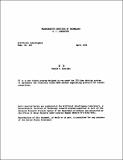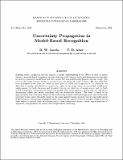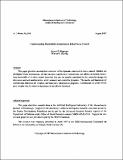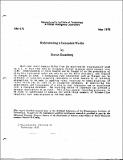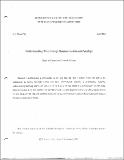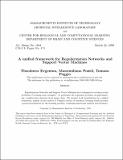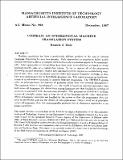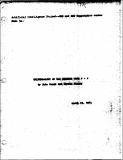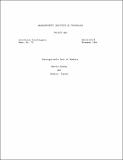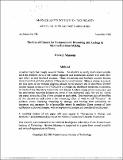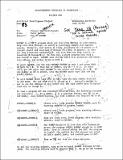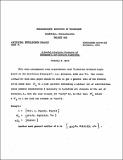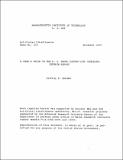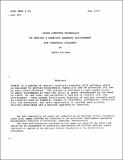Browsing AI Memos (1959 - 2004) by Title
Now showing items 1145-1164 of 1217
-
U.T.: Telnet Reference Manual
(1974-04-01)UT is a user telnet program designed to run under the ITS time sharing system. It implements the relatively recent ARPA network negotiating protocol for telnet connections. -
Uncertainty Propagation in Model-Based Recognition
(1995-02-01)Building robust recognition systems requires a careful understanding of the effects of error in sensed features. Error in these image features results in a region of uncertainty in the possible image location of each ... -
Understanding Bandwidth Limitations in Robot Force Control
(1987-08-01)This paper provides an analytical overview of the dynamics involved in force control. Models are developed which demonstrate, for the one-axis explicit force control case, the effects on system closed-loop bandwidth ... -
Understanding Hand-Printed Algebra for Computer Tutoring
(1977-02-01)This thesis demonstrates how the use of a global context can improve the power of a local character recognizer. The global context considered is a computer tutor of high school algebra that observes a student working ... -
Understanding in Incomplete Worlds
(1978-05-01)Most real world domains differ from the micro-worlds traditionally used in A.I. in that they have an incomplete factual database which changes over time. Understanding in these domains can be thought of as the generation ... -
Understanding Text through Summarization and Analogy
(1983-04-01)Understanding a text exactly in the way that the Text Producer meant the text to be understood is highly unlikely unless the text interpretation process is constrained. Specific understanding-directing criteria are ... -
Understanding Understanding Mathematics
(1978-08-01)In this paper we look at some of the ingredients and processes involved in the understanding of mathematics. We analyze elements of mathematical knowledge, organize them in a coherent way and take note of certain ... -
A Unified Framework for Regularization Networks and Support Vector Machines
(1999-03-01)Regularization Networks and Support Vector Machines are techniques for solving certain problems of learning from examples -- in particular the regression problem of approximating a multivariate function from sparse ... -
A Unified Statistical and Information Theoretic Framework for Multi-modal Image Registration
(2004-04-28)We formulate and interpret several multi-modal registration methods in the context of a unified statistical and information theoretic framework. A unified interpretation clarifies the implicit assumptions of each method ... -
UNITRAN: An Interlingual Machine Translation System
(1987-12-01)This report describes the UNITRAN (UNIversal TRANslator) system, an implementation of a principle-based approach to natural language translation. The system is "interlingual", i.e., the model is based on universal ... -
Universality of TAG Systems with P-2
(1963-04-01)In the following sections we show, by a simple direct construction, that computations done by Turing machines can be duplicated by a very simple symbol manipulation process. The process is described by a simple form of ... -
Unrecognizable Sets of Numbers
(1964-11-01)When is a set A of positive integers, represented as binary numbers, "regular" in the sense that it is a set of sequences that can be recognized by a finite-state machine? Let pie A(n) be the number of members of A less ... -
The Unsupervised Acquisition of a Lexicon from Continuous Speech
(1996-01-18)We present an unsupervised learning algorithm that acquires a natural-language lexicon from raw speech. The algorithm is based on the optimal encoding of symbol sequences in an MDL framework, and uses a hierarchical ... -
The Use of Censors for Nonmonotonic Reasoning and Analogy in Medical Desicion-Making
(1985-11-01)A patient rarely has a single, isolated disease. The situation is usually much more complex since the different parts of the human organism and metabolism interact with each other and follow several feedback patterns. ... -
Use of MACDMP
(1965-07-01)MACIMP is a PDP-6 program which can load from DECtape to core memory, dump core onto DECtape, or verify a previously dumped filel against memory. Normally, just before it loads, it clears all of memory to 0 (except itself ... -
The Use of Parallelism to Implement a Heuristic Search
(1981-03-01)The role of parallel processing in heuristic search is examined by means of an example (cryptarithmetic addition). A problem solver is constructed that combines the metaphors of constraint propagation and hypothesize-and-test. ... -
A Useful Algebraic Property of Robinson's Unification Algorithm
(1965-11-01)This memo presupposes some acquaintance with "A Machine Oriented Logic Based on the Resolution Principle", J.A. Robinson, JACM Jan65. The reader unfamiliar with this paper should be able to get a general idea of the ... -
A User's Guide to the A.I. Group LISCOM LISP Complier: Interim Report
(1970-12-01)The LISCOM version of the AI group PDP/6 LISP compiler is a descendant of the original Greenblatt-Nelson compiler, and is a friendly sibling to the COMPLR version maintained by Jon L. White. The compiler operates in two ... -
Uses of Technology to Enhance Education
(1973-06-01)Section 1: Schematic outline of project and what we want. Hardly any intellectual content. Section 2: Statement of our goals in general terms. This statement is intended to have serious intellectual content but lacks meaty ... -
Using Computer Technology to Provide a Creative Learning Environment for Preschool Children
(1976-05-01)TORTIS is a system of special terminals together with software which is designed to provide programming capability and be accesible for use by very young children. The system is designed to add capabilities in small ...

